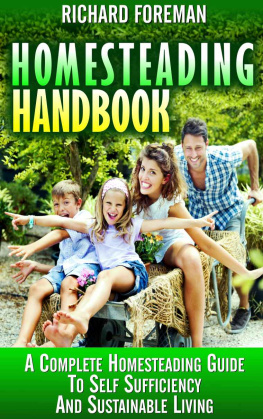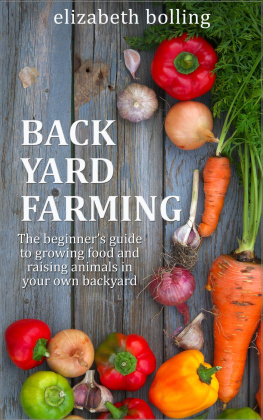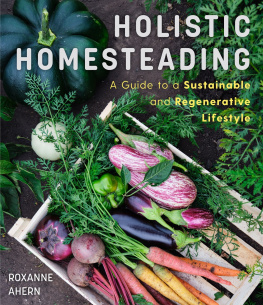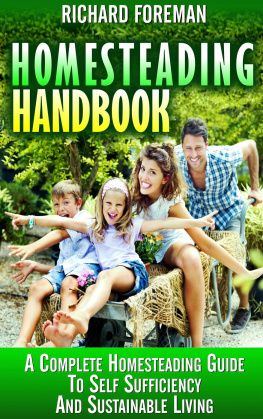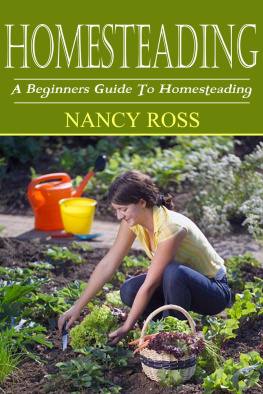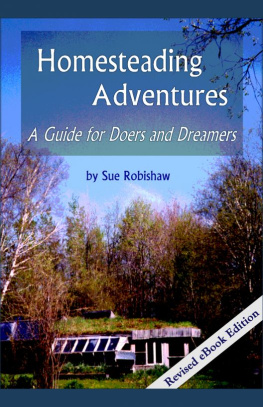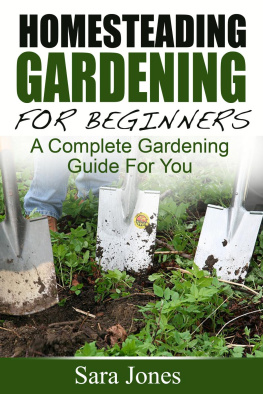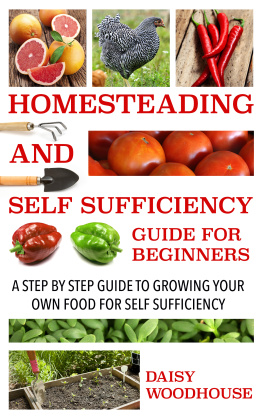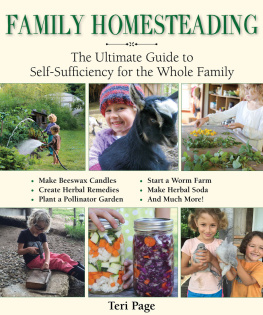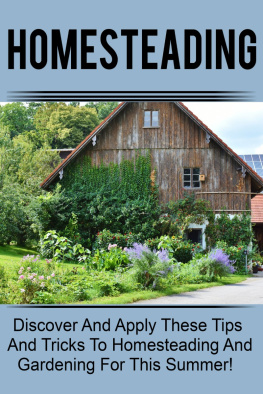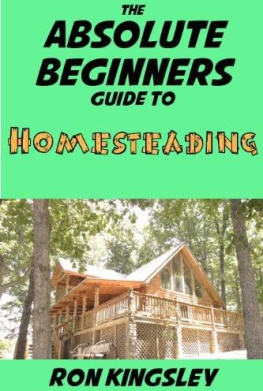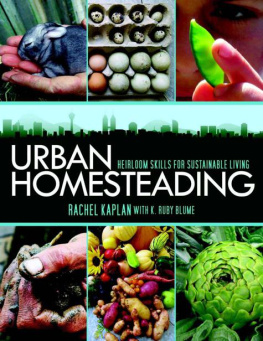HomesteadingHandbook : A Complete Homesteading Guide to Self Sufficiency and SustainableLiving (Homesteading for Beginners, Homesteading Guide, How to Homestead, HomesteadingSkills)
RichardForeman
PUBLISHEDBY:
RichardForeman
Copyright 201
Visitour website to get more books information: justhappyforever.com
All rights reserved.
No part of this publication may becopied, reproduced in any format, by any means, electronic or otherwise,without prior consent from the copyright owner and publisher of this book.
Disclaimer
The information contained in thisebook is for general information purposes only. The information is provided bythe authors and while we endeavor to keep the information up to date andcorrect, we make no representations or warranties of any kind, express orimplied, about the completeness, accuracy, reliability, suitability oravailability with respect to the ebook or the information, products, services,or related graphics contained in the ebook for any purpose. Any reliance youplace on such information is therefore strictly at your own risk.
WAIT! Before youcontinue
Justto say thank you for purchasing this book, I want to give you a 100% FREE GIFT (valued at$5.99) : 10Hot Tips for Eating Right&Losing Weight Fast .
Youwill get the tips for eating right and losing weight fast to make you health.
Click here to access your Freegift
Tableof Contents
Introduction
Understanding Homesteading
Inthis fast-paced technology driven world, the idea of living life at a slow andrelaxing pace has started to gain popularity and acceptance. Rising inflation,overdependence on technology, shortage of resources, pesticides ridden fruitsand vegetables, and not-a-moment-to-catch-my-breath lifestyle have pushed anumber of people into looking at homesteading as a viable lifestyle. Althoughhomesteading is certainly not a new concept, the ideas and concepts of urbanhomesteading has started to gain traction with both the young and the urbanpopulation.
Inthe past, homesteaders spent years undertaking backbreaking tasks of plowing,tilling and harvesting farms carved out of complete wilderness. They stayedaway from modern day amenities and tools. Although, present day homesteaderstoo undertake physically exhaustive tasks, they are, nevertheless, not asgrueling as the olden-day tasks. But, let this not fool you as homesteading present or past is taxing if you do not have the right aptitude to live yourlife without a number of so-called basic amenities that we take for granted.
Alarge number of people are attracted towards homesteading because it helps keepunhealthy and harmful chemicals out of the food chain. Turning to gardening isthe only way to ensure that each and every one of us has access to wholesomeand less-contaminated food. Moreover, people have gone further and have ensuredthat chemicals do not find their way into their personal lives as well. Withevery action they take, homesteaders make sure that they do not harmthemselves, their co-beings, the Earth and the future generations. Call it whatyou may green movement, eco conscious or going green the basic idea thatdefines homesteading is self-sufficiency and environmental responsibility.Homesteading, as difficult and backbreaking it might seem initially, is thefirst step towards a happier, healthier and satisfying lifestyle.
Urbanhomesteading is not a new concept or an idea; in fact, homesteading is as oldas the mountains. Before people started buying bread and eggs from stores,everyone raised poultry in their backyards and baked bread at their homes.Homesteading is an ancient concept; however, urban homesteading has revived theold techniques of self-sufficiency and adapted them to suit the urban dwellersneeds. Urban homesteading is not a single concept; it is a collection ofvarious techniques and practices. It includes growing vegetables and fruits,raising animals, preserving food, making bread, cheese and yogurt at home,spinning and knitting, making cleaning products, using solar and wind energy,conserving water and making fertilizers and compost. The one concept that holdsurban and rural homesteading is the idea of providing for self, resisting thetemptation to binge consumption, consuming products made at home, creatingproducts rather than purchasing mass-produced products from stores.
Ifyou want to live a self-sufficient life, homesteading is a must for you. Homesteading is branded by subsistence farming, home conservation of foodstuffsand it may in certain instances involve a minor production of clothing, fabricsand craftwork for home use or sale.
Homesteadinggenerally makes a distinction from rural commune livelihood by isolation, sociallyor physically of the farm. The usage of this term, in the United States ofAmerica, dates way back to the Homestead Act of 1862 and probably even beforethe 19th century.
Self-sufficiencymovements in the 20thcentury began to use the concept to city andsuburban locations known as urban homesteading. It incorporates smallsustainable farming and homemaking. In homesteading, government and socialsupport coordination are frequently given a wide berth to favor self-relianceand kith and kin deprivation, so as to maximize self-reliance andself-determination.
Thedegree of autonomy happens along a spectrum, with a lot of homesteadersproducing foodstuffs or trades to fascinate high-end niche consumers in orderto cover financial requirements. Some homesteaders turn in to this lifestylefollowing fruitful careers which make available the funding for electricity,generators, land, farm equipment, housing, solar panels and taxes.
Contemporarygovernment rules in the form of structure codes, food welfare programs, zoningguidelines, minimum salary and social security for seasonal labor force. Andtown committee limits on landscaping and animal custody has improved themarginal expense of home production of sustenance.
Combinedwith the late rewards of forming a viable farming site, this increases thehardship of establishing an independent homestead from the ground, particularlyfor those of meager income. Actual monetary savings from implementing ahomesteading existence appear most strongly related to inferior materialsubsistence standards and upkeep of purchased means such as foodstuff,electricity, water and fertilizer rather than decrease costs of existence.
Economiesof measure in modern farming and opportunity cost of physical labor inhibithome-raised food items from being a cost-effective choice. Many homesteadershowever, show deep approval with their standard of existence and feel thattheir way of living is healthier and better rewarding than other conventionalforms of living.
Belowis a partial listing of homesteading abilities that hopefully may inspire newhomesteaders to study. This is highly recommended for young people who wantto dare finding a new approach to life. Each skill that you acquire will be astep nearer to a life of better self-reliance and autonomy.
Fundamentalhomesteading skills consist of learning how to:
- Bake bread;
- Butcher small livestock such as chicken and rabbits;
- Caponize a chicken;
- Choose a location for a vegetable garden or orchard;
- Cook 10 basic meals from scratch on a cook stove;
- Crochet;
- Cut and glaze glass;
- Determine an animals age by its teeth;
- Dig and properly use a shallow well;
- Do basic sewing; and home canning and food preservation;
- Dub a chicken;
- Dye cloth or yarn from plants;
- Entertain yourself and live without electronic media;
- Fillet and clean a fish;
- Graft baby animals onto a foster-mother;
- Grind wheat into flour;
- Grow a vegetable plant and everyday kitchen herbs;

